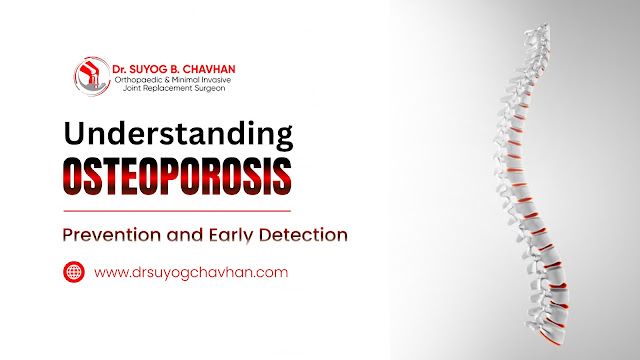Osteoporosis, often termed the “silent disease,” is characterized by weakened bones that are more susceptible to fractures. This condition progresses without noticeable symptoms until a fracture occurs, highlighting the importance of awareness and proactive management. Dr. Suyog Chavhan, a renowned orthopaedic and joint replacement surgeon at SYNTHESIS Orthopaedics & Joint Replacement Clinic, emphasizes that early intervention is key to mitigating the risks associated with osteoporosis.
What Is Osteoporosis?
Osteoporosis is a condition where bones lose density and strength, making them fragile and more likely to break. Common fracture sites include the hip, spine, and wrist. While it predominantly affects older adults, especially postmenopausal women due to hormonal changes, it can also occur in men and younger individuals.
Risk Factors
Several factors can increase the likelihood of developing osteoporosis:
- Age: Bone density naturally decreases with age.
- Gender: Women are at a higher risk, particularly after menopause.
- Family History: A history of osteoporosis in the family can elevate risk.
- Lifestyle Choices: Smoking, excessive alcohol consumption, and a sedentary lifestyle contribute to bone loss.
- Medical Conditions: Chronic diseases such as rheumatoid arthritis and chronic kidney disease can affect bone health.
Prevention Strategies
Preventing osteoporosis involves adopting a bone-healthy lifestyle at all stages of life. Key strategies include:
- Balanced Diet: Ensure adequate intake of calcium and vitamin D to support bone strength.
- Regular Exercise: Engage in weight-bearing and muscle-strengthening exercises like walking, jogging, and resistance training to maintain bone density.
- Healthy Lifestyle Choices: Avoid smoking and limit alcohol intake, as these can accelerate bone loss.
- Fall Prevention: Implement safety measures at home to reduce the risk of falls, such as securing rugs and installing grab bars where necessary.
Early Detection
Early detection of osteoporosis is crucial for effective management. Bone mineral density (BMD) testing, commonly performed using dual-energy X-ray absorptiometry (DEXA), is the standard method for diagnosing osteoporosis. Women aged 65 and older and postmenopausal women under 65 with additional risk factors should undergo screening. Men with risk factors should discuss screening options with their healthcare provider.
Management and Treatment
While there is no cure for osteoporosis, treatment focuses on preventing further bone loss and reducing fracture risk. This may include medications such as bisphosphonates, lifestyle modifications, and addressing underlying medical conditions. Regular follow-ups with a healthcare provider are essential to monitor bone health and adjust treatment plans as needed.
At SYNTHESIS Orthopaedics & Joint Replacement Clinic, Dr. Suyog Chavhan and his team are dedicated to providing comprehensive care for individuals at risk of or diagnosed with osteoporosis. By focusing on prevention, early detection, and personalized treatment plans, they aim to enhance bone health and overall quality of life.
Take Charge of Your Bone Health Today
Don’t wait for a fracture to reveal the state of your bones. Schedule a consultation with Dr. Suyog Chavhan at SYNTHESIS Orthopaedics & Joint Replacement Clinic to assess your bone health and discuss preventive strategies tailored to your needs.
📍 Visit us at:
SYNTHESIS Orthopaedics & Joint Replacement Clinic
📞 Call Now: +91 9082633731
📧 Email: drsuyogchavhan@gmail.com




